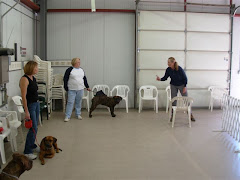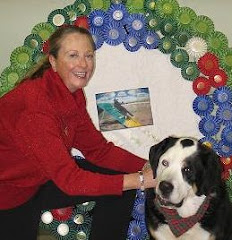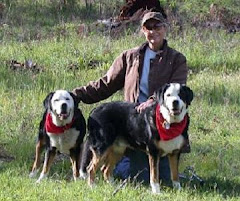.
PLEASE NOTE: My breed profiles deal specifically with the trainability, versatility, and overall character of specific breeds based solely on my experience with them, and observations of them, as a trainer/behaviorist. I'm not an expert in conformation or the common health issues of given breeds. Opinions (yours or mine) are, by nature, biased. However, if you ask most good, highly experienced dog trainers (like the folks at Manning Dog Training in Yakima) our opinions will all be pretty similar.
Photo: The B&W is Rin Tin Tin with Rusty. The colored photo is Tava, a very sweet GSD belonging to Jennifer Allen. Tava has done well in Rally and Obedience competition, but is typically shy of new people and new situations.
German Shepherd Dogs: Highly intelligent, high energy, playful, keen senses, nervous, reactive, sometimes explosive, distrusting of strangers, gentle with family, fiercely loyal to one person.
People have often asked me, “What's one of the hardest breeds to train?”
They're usually shocked at my unhesitating answer: “German Shepherds.”
“Really!” they'll come back. “I always thought they were so smart...you know, like Rin Tin Tin, and all those guide dogs.”
They are smart. But German Shepherds aren't what they used to be. There's a lot of bad breeding out there, and a lot of unbalanced dogs.
For decades now, the German Shepherd Dog (GSD) has made the top 10 most popular AKC breeds in the United States. It soared in popularity back in the '50s when “Rin Tin Tin” hit the black and white boob tube. The show was about a boy named Rusty, growing up on a remote Army Cavalry post, with his faithful GSD companion, Rin Tin Tin.
Because everyone wanted their own Rinty, breeding surged in order to meet the demand. This noble breed did indeed live up to its expectations, and German Shepherds became the icon for guard dogs, “police dogs,” guide dogs for the blind, and trusted babysitters.
But popularity is the worst thing that can happen to a breed. The hot market encouraged a lot of casual breeding, and the German Shepherd's gene pool suffered in the United States. The American Kennel Club revised its standards for the breed, preferring a look that only slightly resembled the true GERMAN Shepherd Dogs that actually came from Germany. The AKC's German Shepherd was smaller, more slightly built, and had low-slung hips that made the dog look (depending on your perspective) like he was about to launch forward at a 40-degree angle... or like he was crippled in the hindquarters.
Most American-bred German Shepherd Dogs, include “show dogs,” now lean toward this look. This is not what Rin Tin Tin looked like. Nor does this new dog act like Rin Tin Tin. And therein lies the challenge in training him.
Keep in mind the GSD is a “herding” dog, before he's a guard dog. Herders are reactive, quick, keenly tuned in to their environments, and ready to move. GSDs have big mouths, big teeth and a big bark, which they will use to intimidate if they have to. They're generally not fighters, nor are they usually “aggressive.” In fact, today's American GSDs tend to be more fearful than frightful. They may bite if backed into a corner, or they'll take a “cheap shot” at an intruder...in other words, they'll dash in, strike (bite), and dash away again. They are not particularly trusting of anything new. With other dogs, GSDs may passively sit on the sidelines and watch the action, and then suddenly explode toward another dog that crosses their path.
The GSD's herding instinct makes it more challenging to get the dog to elevate his face and pay attention to his human leader. He likes to keep his head low and muzzle slanted downward, so he can look BEYOND the handler, at ankle height, at whatever action is happening in the background. He's always checking his perimeters. It's not uncommon for an GSD to jab at his handler's ankles or feet. (He is herding, after all.)
GSDs are extremely loyal to their owners and rarely will work for anyone else. There's no doubt a GSD will lay his life on the line for his owner...and yet a young GSD may suffer an emotional meltdown at his first dog show. Then can become shrinking violets, trying to hide behind their handler when approached by a stranger.
My training recipe for this breed: calmness, patience and consistency, with lots of positive feedback. He needs plenty of early and gentle socialization. When it comes to serious training, the GSD is best started in a quiet, distraction-free atmosphere where he has the ability to focus on his handler and think through his actions. Once he's familiar with some commands and concepts, the handler can start slowly introducing small distractions to proof the dog. Do not overwhelm this dog. Socialization as a small puppy is extremely important, and obedience commands should be incorporated into the dog's daily schedule.
If handled correctly by an even-keeled person, this dog can be the best of the best in all the performance events like obedience, agility and tracking. The bonding that develops between the owner and dog throughout the training process becomes so strong that this dog will scarcely listen to any other person.
The prerequisite to owning a German Shepherd Dog is that you already LOVE the breed for what it is today, not for what you saw on TV reruns.
PLEASE NOTE: My breed profiles deal specifically with the trainability, versatility, and overall character of specific breeds based solely on my experience with them, and observations of them, as a trainer/behaviorist. I'm not an expert in conformation or the common health issues of given breeds. Opinions (yours or mine) are, by nature, biased. However, if you ask most good, highly experienced dog trainers (like the folks at Manning Dog Training in Yakima) our opinions will all be pretty similar.
Photo: The B&W is Rin Tin Tin with Rusty. The colored photo is Tava, a very sweet GSD belonging to Jennifer Allen. Tava has done well in Rally and Obedience competition, but is typically shy of new people and new situations.
German Shepherd Dogs: Highly intelligent, high energy, playful, keen senses, nervous, reactive, sometimes explosive, distrusting of strangers, gentle with family, fiercely loyal to one person.
People have often asked me, “What's one of the hardest breeds to train?”
They're usually shocked at my unhesitating answer: “German Shepherds.”
“Really!” they'll come back. “I always thought they were so smart...you know, like Rin Tin Tin, and all those guide dogs.”
They are smart. But German Shepherds aren't what they used to be. There's a lot of bad breeding out there, and a lot of unbalanced dogs.
For decades now, the German Shepherd Dog (GSD) has made the top 10 most popular AKC breeds in the United States. It soared in popularity back in the '50s when “Rin Tin Tin” hit the black and white boob tube. The show was about a boy named Rusty, growing up on a remote Army Cavalry post, with his faithful GSD companion, Rin Tin Tin.
Because everyone wanted their own Rinty, breeding surged in order to meet the demand. This noble breed did indeed live up to its expectations, and German Shepherds became the icon for guard dogs, “police dogs,” guide dogs for the blind, and trusted babysitters.
But popularity is the worst thing that can happen to a breed. The hot market encouraged a lot of casual breeding, and the German Shepherd's gene pool suffered in the United States. The American Kennel Club revised its standards for the breed, preferring a look that only slightly resembled the true GERMAN Shepherd Dogs that actually came from Germany. The AKC's German Shepherd was smaller, more slightly built, and had low-slung hips that made the dog look (depending on your perspective) like he was about to launch forward at a 40-degree angle... or like he was crippled in the hindquarters.
Most American-bred German Shepherd Dogs, include “show dogs,” now lean toward this look. This is not what Rin Tin Tin looked like. Nor does this new dog act like Rin Tin Tin. And therein lies the challenge in training him.
Keep in mind the GSD is a “herding” dog, before he's a guard dog. Herders are reactive, quick, keenly tuned in to their environments, and ready to move. GSDs have big mouths, big teeth and a big bark, which they will use to intimidate if they have to. They're generally not fighters, nor are they usually “aggressive.” In fact, today's American GSDs tend to be more fearful than frightful. They may bite if backed into a corner, or they'll take a “cheap shot” at an intruder...in other words, they'll dash in, strike (bite), and dash away again. They are not particularly trusting of anything new. With other dogs, GSDs may passively sit on the sidelines and watch the action, and then suddenly explode toward another dog that crosses their path.
The GSD's herding instinct makes it more challenging to get the dog to elevate his face and pay attention to his human leader. He likes to keep his head low and muzzle slanted downward, so he can look BEYOND the handler, at ankle height, at whatever action is happening in the background. He's always checking his perimeters. It's not uncommon for an GSD to jab at his handler's ankles or feet. (He is herding, after all.)
GSDs are extremely loyal to their owners and rarely will work for anyone else. There's no doubt a GSD will lay his life on the line for his owner...and yet a young GSD may suffer an emotional meltdown at his first dog show. Then can become shrinking violets, trying to hide behind their handler when approached by a stranger.
My training recipe for this breed: calmness, patience and consistency, with lots of positive feedback. He needs plenty of early and gentle socialization. When it comes to serious training, the GSD is best started in a quiet, distraction-free atmosphere where he has the ability to focus on his handler and think through his actions. Once he's familiar with some commands and concepts, the handler can start slowly introducing small distractions to proof the dog. Do not overwhelm this dog. Socialization as a small puppy is extremely important, and obedience commands should be incorporated into the dog's daily schedule.
If handled correctly by an even-keeled person, this dog can be the best of the best in all the performance events like obedience, agility and tracking. The bonding that develops between the owner and dog throughout the training process becomes so strong that this dog will scarcely listen to any other person.
The prerequisite to owning a German Shepherd Dog is that you already LOVE the breed for what it is today, not for what you saw on TV reruns.


















No comments:
Post a Comment